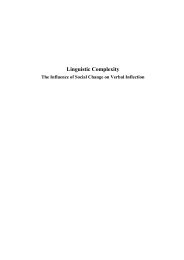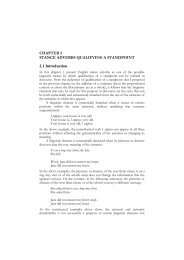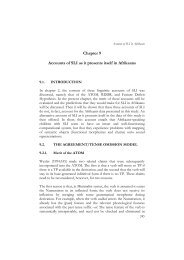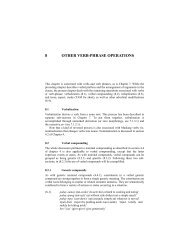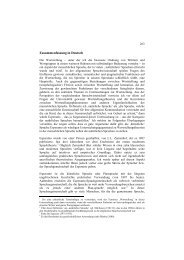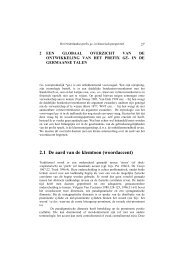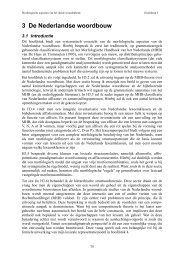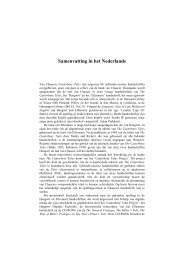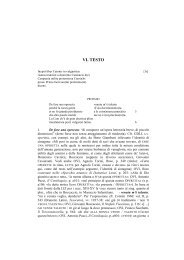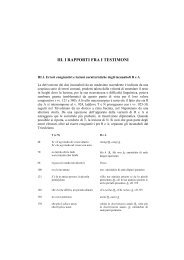Chapter 2 - LOT publications
Chapter 2 - LOT publications
Chapter 2 - LOT publications
You also want an ePaper? Increase the reach of your titles
YUMPU automatically turns print PDFs into web optimized ePapers that Google loves.
The Causative in Oromo<br />
2. The Causative in Oromo<br />
2.1. Introduction<br />
A causative situation minimally consists of two events: the causing event and the<br />
caused event. Such events can be expressed either syntactically or morphologically.<br />
In syntactic causatives, causative events are expressed by two clauses: the matrix<br />
clause which contains the causer event and the embedded clause which contains the<br />
causing event. In the case of morphological causatives the causative situation contains<br />
the causer, the causee and the morphological causative marking on the verb.<br />
Kulikov (2001:886) defines causatives “as verbs which refer to a causative situation,<br />
that is, to a causal relation between two events, one of which (P2) is believed by the<br />
speaker to be caused by another (P1)”. As Kulikov notes, such a definition is general<br />
because it includes all types of causative verbs and structures regardless of their<br />
paradigmatic and syntagmatic relations in a given language. In other words, such a<br />
definition is not important for the description of particular languages. For the description<br />
of individual languages a narrower definition of the causative is required.<br />
Thus, in the narrower sense (Kulikov 2001: 888), causatives which fulfil the following<br />
characteristics are treated as causative proper: causatives which “ (i) stand in<br />
regular opposition both formally and semantically to the corresponding noncausatives<br />
within the verbal system of a given language, (ii) are formally more complex<br />
than their non-causative counterparts, and (iii) represent a more or less productive<br />
formation.” I use the narrower sense of the causative event as a tool to identify<br />
types of causative-non-causative oppositions in particular languages.<br />
In this chapter I focus on interesting aspects of Oromo causatives. Four issues are<br />
areas of interest in Oromo causatives: the forms of causative morphemes, double<br />
causatives, impersonal causatives and intransitive causatives. I differentiate the following<br />
causative morphemes which I call CAUS 1 (-is-/-s-/- ss-), CAUS 2 (-sis-),<br />
and CAUS 3 (-eess-). The morpheme –ss- had not been recognized before; this morpheme<br />
is a free variant of –s-. Synchronically CAUS 2 has to be distinguished from<br />
the sequence of CAUS 1 -CAUS 1 . I shall show that there is productive formation of<br />
double causatives in Oromo. I also show that the number of –s-‘s does not always<br />
match with the number of agents as has been claimed by Lloret (1987) and others.<br />
Moreover, I discuss impersonal/causerless causatives. These are causative structures<br />
that have no causer or subject. I also show the function of a causative as a verbalizer.<br />
In Oromo causative morphemes are used as verbalizers, among others, of ideophones.<br />
Such verbalized ideophones are often intransitive causatives. The semantic<br />
typology of causatives in Kulikov (2001) is used to study the semantic range of<br />
Oromo causatives. In this language only indirect, assistive and similative causatives<br />
show grammatical differences correlating with semantic differences. The other types<br />
11
<strong>Chapter</strong> 2<br />
of causatives in Kulikov’s typology are within the range of the functions of the<br />
common causative suffix.<br />
The remainder of the chapter is organized into five sections. 2.2. discusses forms of<br />
causative morphemes. 2.3. considers causative structures such as double, subjectless<br />
and intransitive causatives. 2.4. discusses the semantics of Oromo causatives while<br />
2.5. discusses argument structures with respect to numbers of agents and causers.<br />
2.2. Forms of the Causative<br />
In Oromo the morpheme –is- or –s- derives single causatives while the morpheme<br />
-sis- can be used in single and double causatives. The form –ss- marks a<br />
single causative and is a variant of –s-. The morpheme –(e)ess- is de-adjectival/denominal<br />
causative morpheme.<br />
Table of Oromo Causative morphemes<br />
Label Form meaning<br />
CAUS 1 -is-/-s-/- ss causative<br />
CAUS 2 -sis causative<br />
CAUS 3 -eess de-adjectival verbalizer, similative<br />
CAUS 1 -CAUS 1 -is-is, -s-iis double causative<br />
CAUS 1 -CAUS 1 -CAUS 1 -s-is-iis triple causative<br />
2.2.1. The Morphemes -is/-s/-ss (CAUS 1 ) and –sis (CAUS 2 )<br />
In this section I show that the morphemes –is- and –s- are suffixed to verb stems to<br />
derive causative verbs. In my analysis these morphemes are considered to be allomorphs.<br />
The morpheme –is- a common causative marker in Oromo (see also Hayward<br />
1976). The causative morpheme –is- suffixed to some intransitive verbs such<br />
as raff-is- ‘make sleep’ and damk’-is- ‘wake up (tr.)’. It is also suffixed to causative<br />
bases as in dubb-is-iis- ‘make greet’ and gog-s-iis- ‘make dry’, etc. The<br />
morpheme –is- is highly productive in the derivation of de-adjectival bases. These<br />
de-adjectival bases are transitives. For instance, verbs such as gudd-is- ‘grow (tr.)’<br />
and furd-is- ‘make fat’ are derived from adjectival roots guddaa ‘big’, furdaa<br />
‘fat’. Similarly, this morpheme could be suffixed to nominal bases to derive causative<br />
verbs as in dubb-is- ‘greet’ which is derived from dubbii ‘talk’.<br />
Similarly the morpheme –s- is a causative morpheme (see also Lloret 1987). In most<br />
cases it is suffixed to non-agentive intransitive verbs such as dab- ‘bend’, gog- ‘to<br />
dry’ to derive causative verbs such as dab-s- ‘bend’ and gog-s- ‘to dry’. It is also<br />
suffixed to agentive intransitive verbs such as fiig- ‘run’ and mak’- ‘drop in’ to derive<br />
causative verbs fiig-s- ‘make run’ and mak’-s- ‘make drop in’.<br />
12
The Causative in Oromo<br />
The causative form –ss- is abundant; it is a free variant of the morpheme –s- as<br />
shown in the following structures:<br />
1a. uffat-ni diriir-e<br />
clothes-NOM spread-3M:PF<br />
‘Clothes spread.’<br />
1b. gurbaa-n uffata diriir-s-e<br />
boy-NOM clothes spread- CAUS 1 -3M:PF<br />
‘A boy spread clothes.’<br />
1c. gurbaa-n uffata diriir-ss-e<br />
boy-NOM clothes spread- CAUS 1 -3M:PF<br />
‘A boy spread clothes.’<br />
In (1a) the verb diriir- ‘spread’ is a non-agentive intransitive because the subject<br />
uffat-ni ‘clothes’ is not capable of performing the action of spreading. As it is<br />
shown in (1b) the stem diriir- ‘spread’ takes the causative morpheme –s-; meanwhile<br />
the agentive subject, gurbaa-n ‘a boy’ is introduced. In (1c) the causative<br />
morpheme is geminated; yet the meaning of the structure is the same as (1b). Nonagentive<br />
intransitive verbs such as gog- ‘to dry (int.)’ show similar characteristics<br />
as in gog-s- ‘to dry (tr.)’ and gog-ss- ‘to dry (tr.). Similarly agentive intransitive<br />
verbs such as mak’- ‘drop in’ take either –s- or –ss-. But, in verbs such as deebis-<br />
‘return something’, fač’aas- ‘to sow’, the causative morpheme cannot be geminated.<br />
If the causative morpheme is doubled as in č’absis- ‘make break’, the first –s- can<br />
be geminated; but in the morpheme –sis- that is added to bases of some agentive<br />
intransitive verbs no –s- is geminated. For instance, in the causative verb kolf-isiis-<br />
‘make laugh’ no –s- is geminated. The –s- of causative can always be geminated<br />
unless it is preceded by a vowel.<br />
In some cases the suffixation of the morpheme –s- triggers assimilation. Particularly<br />
when the causative morpheme –s- is added to verb stems with final /l/ a morphophonological<br />
process takes place in the sense that the causative –s- is realized<br />
as -čč- or –šš- after stem final /l/ and this final stem /l/ is sometimes dropped<br />
(Hayward 1976; Lloret 1987). For example, bul- ‘to spend the night’ + -s- derives<br />
the causative verb bulčč- /bu(l)šš- ‘make to spend the night’ 5 . Kebede (1994: 34-35)<br />
also notes that in Baate (Wollo) Oromo the causative verb of bul- becomes bušš-.<br />
As compared to the –is- and –s- forms the morpheme –sis- contains two -s-’s. Because<br />
of this, –sis- appears to be a double causative. But, this morpheme could be a<br />
single or a double causative form. I consider a form a double causative if it contains<br />
5<br />
The form bulčči ‘spend the night’ is in the dialect of Shoa Oromo. The form bu(l)šši<br />
‘spend the night’ is in the dialect of Wollega Oromo.<br />
13
<strong>Chapter</strong> 2<br />
a double causative derivation. Some instances of –sis- represent a double causative<br />
derivation –s-is; others are to be considered as a single morpheme. Some agentive<br />
intransitive verbs and many transitive verbs permit only the suffixation of –sis-. For<br />
instance, causatives deem-sis- ‘make go’ and kolf-isiis- ‘make laugh’ are single<br />
causatives because forms such as *deem-is- and *kolf-is- are not acceptable. Similarly<br />
single causatives of transitive verbs such as bar- ‘learn’, arg- ‘to see’, hoɗ-<br />
‘embroider’ are bar-sis- ‘teach’, arg-sis- ‘show’ and hoɗ-siis- ‘make embroider’<br />
respectively. The same morpheme could be productively used as a double causative.<br />
For instance, a double causatives of single causatives fiig-s- ‘make run’, gog-s-<br />
‘make dry’, dab-s- ‘make bend’ are fiig-s-is- ‘make somebody to make run someone’,<br />
gog-s-iis- ‘make somebody to dry something’, dab-s-iis ‘make somebody to<br />
bend something’. The /i/ between the two -s-’s varies between short and long. Such<br />
variation is accounted for in terms of vowel length dissimilation rule (see also Lloret<br />
1987:146).<br />
The consequence of using –sis- as a single causative morpheme is that the number<br />
of underlying agents are not always directly linked to the number of –s-’s because<br />
-sis- has two –s-’s; yet, it functions as a single causative morpheme as has<br />
been shown above in causatives such as deem-sis- ‘make go’ and kolf-isiis- make<br />
laugh’. Moreover, there is a geminated form, namely –ss- which is used as a single<br />
causative marker (see also 2.8. in this chapter).<br />
2.2.2. The Morpheme –eess (CAUS 3 )<br />
The morpheme –eess- is one of the of causative morphemes which is suffixed to<br />
adjectival stems such as add- ‘white’ and jab- ‘strong’ to derive add-eess-<br />
‘whiten’ and jab-eess- ‘strengthen’ respectively (see section 2.8.5 in this chapter).<br />
The form –ess and –eess are are accounted for in terms of vowel dissimilation rule<br />
(see Kebede 1994). The morpheme -eess- is distinct from -s-, -is- and –sis- and<br />
cannot be suffixed to bases of intransitives and transitive verbs. The causative morpheme<br />
–eess- is a verbalizing morpheme which is suffixed to adjectival bases such<br />
as guraačča ‘black’, fagoo ‘far’, ɗiyoo ‘near’, etc. This analysis is confirmed when<br />
we observe related Cushitic languages such as Kambaata, Hadiya, Sidama and Afar.<br />
2.3. Structure of the Causative<br />
2.3.1. Double Causatives<br />
In Oromo all causative bases can be doubled. Double causatives refer to indirect<br />
causative events. When one more causative morpheme is suffixed to the causative<br />
base always another external causer is introduced. This is true for causatives of nonagentive<br />
intransitives, agentive intransitives and transitive verbs as shown below:<br />
14
The Causative in Oromo<br />
2a. sibiill-i dab-e<br />
iron-NOM bend-3M:PF<br />
‘Iron is bent.’<br />
2b. gurbaa-n sibiila 6 dab-s-e<br />
boy-NOM iron bend- CAUS 1 -3M:PF<br />
‘A boy bent iron.’<br />
(2a) is non-agentive intransitive; the noun sibiill-i ‘iron’ is not the agent of the<br />
event. (2b) is a causative structure in which the causative morpheme –s- is suffixed<br />
to the verb root dab- ‘bend’. The suffixation of the causative morpheme is accompanied<br />
by the addition of the agentive subject gurbaa-n ‘a boy’. The causative verb<br />
dabs- ‘bend’ can be further doubled and tripled to add more agentive subjects as in<br />
(3):<br />
3a. nam-ičč-i gurbaa sibiila dab-s-iis-e<br />
man-DET-NOM boy iron bend- CAUS 1 - CAUS 1 -3M:PF<br />
‘The man made a boy bend iron.’<br />
3b. Tarfaa-n nam-ičča-an gurbaa sibiila<br />
Tarfaa-NOM man-DET-INST boy iron<br />
dab-s-is-iis-e<br />
bend- CAUS 1 - CAUS 1 - CAUS 1 -3M:PF<br />
‘Tarfa made the man make a boy bend iron.’<br />
In (3a) the causative morpheme –is- is suffixed to the verb dabs- ‘bend’ to derive<br />
the complex causative verb dabsiis- ‘make bend’; meanwhile an agentive subject<br />
nam-ičč-i ‘the man’ is added. In (3b) the verb dabsiis- is further causativized as<br />
dabsisiis- ‘made make bend’ by adding the causative morpheme –is- which is accompanied<br />
by the agentive subject Tarfaa-n; the main causee is now expressed as<br />
an object of instrument.<br />
Agentive intransitives also add two causative morphemes to derive double causatives<br />
as shown in (4):<br />
4a. gurbaa-n fiig-e<br />
boy-NOM run-3M:PF<br />
‘A boy ran.’<br />
6<br />
The nominal sibila ‘iron’ has a non-geminated /l/ in the absolutive form but the geminated<br />
/ll/ in the nominative form, as a reflex of nominative –ni.<br />
15
<strong>Chapter</strong> 2<br />
4b. nam-ičč-i gurbaa fiig-s-e<br />
man-DET-NOM boy run- CAUS 1 -3M:PF<br />
‘The man made a boy run.’<br />
4c. Tarfaa-n nam-ičča-an gurbaa fiig-s-is-e<br />
Terfaa-NOM man-DET-INST boy run- CAUS 1 - CAUS 1 -3M:PF<br />
‘Tarfa made the man make a boy run.’<br />
(4a) is a structure of agentive intransitive event. In this structure gurbaa-n is the<br />
agent while fiig- ‘run’ is the verb. (4b) is a causative structure in which the causative<br />
morpheme –s- and the agent nam-ičč-i ‘the man’ are added to the structure of (4a).<br />
In (4c) the causative verb fiigs- ‘make run’ is further causativized by adding additional<br />
causative morpheme –is-. This time the agent Tarfaa-n is added as a causer<br />
of the event.<br />
Transitive verbs are also causativized and further re-causativized by adding causative<br />
morphemes and agentive subjects (see Owens 1985a):<br />
Owens 1985a: 6.<br />
5a. an Muusaa-n isa eeruu k’očč-isiis-is-e<br />
I Muusaa-INST him:ABS field till- CAUS 2 - CAUS 1 -3M:PF<br />
‘Through Musa I made him till a field.’<br />
5b. an Muusaa-n eeruu isa k’očč-isiis-is-e<br />
I Muusaa-INST field him:ABS till- CAUS 2 - CAUS 1 -3M:PF<br />
‘I made Musa make him till a field.’<br />
The verb k’očč-isiis- ‘make till’ is a causative verb of a transitive verb k’ot- ‘to till’<br />
while the double causative verb k’očč-isiis-is- ‘made make till’ is derived from the<br />
causative verb k’očč-isiis- ‘make till’. In both structures an ‘I’ and Musaa are<br />
causer and causee respectively. In (5a) the causee isa ‘him’ precedes the patient eeruu<br />
‘field’; while in (5b) the patient eeruu ‘field’ precedes the causee isa ‘him’.<br />
According to Owens, the difference between the two structures is semantic in the<br />
sense that in (5a) the intention of the causer is to get isa ‘him’ till the ground<br />
through Muusaa. In this case Muusaa is the intermediary participant for the action<br />
to take place. But in (5b) the intention of the causer is to get Muusaa (not another<br />
person) make the causee isa ‘him’ to till a field. In my dialect (Meč’a) there is no<br />
difference, in meaning between (5a) and (5b). It is possibly true for Harar, the dialect<br />
that Owens (1985a) studied.<br />
Generally, in Oromo the causative suffix is sequentially added to causative verbs to<br />
derive double and triple causatives. Of course, one question is posed at this juncture:<br />
what is the limit of extending the causativaization process? My observation is that<br />
double causative is common in Oromo; and triple causative is rare although the pos-<br />
16
The Causative in Oromo<br />
sibility of extending the process is there. If the process goes further than triple causativization,<br />
it indicates causation in which X causes Y causes Z causes N (variables<br />
such as X, Y, Z, N indicate participants). In such cases only two or three participants<br />
are expressed while the rest are omitted. Pragmatically, it is strange if more than two<br />
agent arguments precede the complex causative verb. That is why one of the three<br />
agents is dropped in most cases.<br />
2.3.2. Causerless/Subjectless (Impersonal) Causatives<br />
Oromo causerless causatives have not been treated in the linguistic literature. Yet,<br />
there are cases in which causative structures appear without subjects. Subject marking<br />
on the verb is sufficient in the sense that no explicit subject or pronoun is required.<br />
Impersonal causative constructions have 3M default subject which is unspecified.<br />
Most of these verbs are verbs of desire as we observe from the following<br />
instances:<br />
6.a ibsaa isa barbaačč-is-a<br />
light:ABS him:ABS look for -CAUS 1 -3M:IMPF<br />
‘He needs light.’/lit., ‘It makes him look for light.’<br />
6b. inni isaan ibsaa barbaačč-is-e<br />
he:NOM him:INST light:ABS look for-CAUS 1 -3M:PF<br />
‘He made him look for light.’<br />
7a. farsoo isa haww-isiis-a<br />
local beer:ABS him:ABS wish for- CAUS 2 -3M:IMPF<br />
‘He needs local beer.’ Lit., ‘It makes him wish for local beer.’<br />
7b. inni farsoo haww-e<br />
he:NOM local beer:ABS wish for for-3M:PF<br />
‘He wished for local beer.’<br />
The verb barbaad- ‘look for’ from which barbaačč-is- ‘make look for’ is derived<br />
is a transitive verb. This means that when a causative morpheme is added to such a<br />
verb, normally, another external argument or causer is added. But in (6) the causative<br />
verb barbaačč-is- ‘make look for’ does not show such characteristics. The construction<br />
is without an explicit causer. Neither ibsaa ‘light’ nor isa ‘him’ is agent of<br />
this structure as both are not marked for nominative case, both are in absolutive<br />
forms; ibsaa ‘light’ is a patient and isa ‘him’ is the causee. In causatives with an<br />
explicit causer the causee usually precedes the patient as in (6b) where the causee is<br />
marked with an intrumnetal suffix and the subject has nominative case. Both (6a)<br />
and (7a) are causerless structures. In these structures the subject agreement on the<br />
verb shows the subject is a default third person singular masculine.<br />
17
<strong>Chapter</strong> 2<br />
But if the causee (‘woman’ in 8a) is a nominal element and not a pronominal element,<br />
then the patient (‘light’ in 8a) which is sentence initial can be marked for a<br />
nominative case as shown below:<br />
8a. ibsaa-n dubartii barbaačč-is-a<br />
light-NOM woman look for- CAUS 1 -3M:IMPF<br />
‘A woman needs light.’ / lit., ‘It makes woman look for light.’<br />
8b. dubartii-n bišaan barbaad-de<br />
woman-NOM water look for-3F:PF<br />
‘A woman looked for water.’<br />
9a. biiftuu-n baa-te<br />
sun-NOM rise-3F:PF<br />
‘The sun rose.<br />
9b. biiftuu-n nama barbaačč-is-a<br />
sun-NOM man look for- CAUS 1 -3M:IMPF<br />
‘Human being needs sun.’/lit., ‘It makes human being need sun.’<br />
Although they are marked for nominative case, initial constituents ibsaa-n ‘light’<br />
and biiftuu-n ‘the sun’ are not the subjects of (8a) and (9b) as it is clear from the<br />
third person masculine agreement on the verb; ‘light’ is masculine while ‘sun’ is<br />
feminine but has no subject agreement on the verb which has a 3M ending, despite<br />
the fact that the nominal ‘sun’ has nominative case in (9b). In constructions with<br />
impersonal passives we will encounter similar cases of sentence initial consituents<br />
being marked by the nominative but not being subject.<br />
In subjectless causative structure the causer is not present in the event. In this type of<br />
structure, word order is strict and not free: the patient precedes the causee which is<br />
followed by the causative verb. In most cases such event is expressed by imperfective<br />
aspect. Similar to impersonal passives, the subject agreement element on the<br />
verb is the third person masculine singular (see <strong>Chapter</strong> 7). Subjectless causative<br />
verbs are single causatives; they have only one single causative morpheme attached<br />
to their bases. These causative verbs typically occur with verbs of desire and we will<br />
see that in Anharic they are restricted to verbs of desire. Subjectless causative verbs<br />
such as ɗaraa-sis- ‘long for’, haww-isiis- from haww- ‘to wish for’, ɗara-sis-<br />
from ɗaraʔ- ‘long for’ and kajel-sis- from kajel- ‘want’ do not allow expression of<br />
a causer in other constructions while the verb barbaačč-is- ‘make look for’ does.<br />
Verbs such as ɗaraa-sis- ‘make long for’ differ from barbaačč-is- ‘make look<br />
for’ because of their lexical properties in the sense that the former is purely a verb of<br />
desire while the latter can be a verb of desire and causative verb as shown in (10).<br />
18
The Causative in Oromo<br />
10. isaa-n Tolassa-tiin kitaaba barbaačč-is-ani<br />
they-NOM Tolasa-INST book look for-CAUS 1 -3P:PF<br />
‘They made Tolasa look for a book.’<br />
11. *isaa-n Tolassa-tiin kitaaba ɗaraa-sis- ani<br />
they-NOM Tolasaa-INST book long for- CAUS 2 -3P:PF<br />
‘They made Tolasa long for a book.’<br />
In Oromo the causative verbs that can appear in subjectless causative structure are<br />
not only ‘desire’-verbs. For instance, causatives of ingestive verbs such as ňaaččis-<br />
‘make eat’, beel-eess- ‘make hungry’; emotion verbs such as arab-sis- ‘make<br />
insult’, aar-s- ‘make angry’; cognitive verbs such as irranfačč-iis- ‘make forget’,<br />
yaadačč-iis- ‘make remind/think’; motion verbs such as fiig-s- ‘make run’ and<br />
deem-sis- ‘make go’; causative verbs such as gurgur-siis- ‘make sell’ could be<br />
used in subjectless causative structures but they oscillate between a causative with<br />
omitted causer and a causerless causative whereas verbs such as bar-sis- ‘make<br />
know/teach’ are less acceptable in causerless causative structure because the cognitive<br />
verb ‘to make know’ expresses activities where a causee is actively and consciously<br />
involved in the activity expressed by the verb as opposed to impersonal<br />
causatives where the causee has low level of involvement with respect to the event<br />
(see <strong>Chapter</strong> 5). Cognitive verbs such as irranfačč-iis- ‘make forget’ and yaadaččiis-<br />
‘make remind/think’ differ from the verb bar-sis- ‘make know/teach’ in the<br />
sense that in the former two the conscious involvement of the causee is low as compared<br />
to the latter.<br />
2.3.3. De-ideophonic Verbalizers<br />
Suffixation of the causative morpheme –is- results in the addition of an element to<br />
the argument structure. Yet, this is not always the case because the causative in its<br />
function as a verbalizer derives intransitive verbs from ideophones. This means that<br />
Oromo has some intransitive causatives, that is intransitive verbs with causative<br />
morphemes. Semantically such intransitive causatives are of two types: motion<br />
verbs and sound emission verbs. Intransitive causatives which indicate motion are as<br />
follows:<br />
19
<strong>Chapter</strong> 2<br />
12. k’orp’p’is-n k’orop’p’-is-e<br />
grasshopper-NOM jump- CAUS 1 -3M:PF<br />
‘A grasshopper jumped.’<br />
13. k’orp’p’is-n barr-is-e<br />
grasshopper-NOM fly- CAUS 1 -3M:PF<br />
‘A grasshopper flew.’<br />
(12) and (13) are intransitive causative of motion verbs. All structures have only one<br />
agentive subject. Despite the presence of the causative marking –is- no additional<br />
subject is introduced. There are also similar verbs such as daadd-is- ‘to start walking<br />
(for a child)’. This intransitive causative is derived from a nominal form daaddee<br />
‘walking of a child’. Verbs such as t’all-is- ‘to struggle to survive’ and k’at’t’is-<br />
‘to walk cautiously and slowly’ are intransitive causatives which are derived<br />
from ideophones. The fact that –is- could be dropped when the corresponding stems<br />
are used with the verb jeɗ ‘to say’ to express the same concept shows that –is- is not<br />
part of the verb root. For instance verbs such as k’orop’p’ jeɗ- ‘to jump/ lit., to say<br />
jump’, barr jeɗ- ‘to fly/lit., to say fly’, t’alt’al jeɗ- ‘to struggle for survival’, k’at’<br />
jeɗ- ‘to stop/lit., to say stop’ are ideophonic verbs. In these forms the causative –is-<br />
alternates with the verb to say jeɗ- ‘say’. Sound emission intransitive causatives<br />
include verbs such as korr-is- /korr jeɗ- ‘to moan’, č’all-is- / č’all jeɗ- ‘to be<br />
quiet’, girr-is / girr jeɗ- ‘to blaze’, etc. Ideophones can be used as verbs either by<br />
compounding them into the verb ‘to say’ or by verbalizing them through a causative<br />
suffix –is, CAUS 1 . Note that this de-ideophonic verbalizing causative is different in<br />
form from the de-adjectival verbalizer –(e)ess- CAUS 3 .<br />
2.4. The Semantics of Oromo Causatives<br />
I discuss the meanings of Oromo causatives on the basis of Kulikov (2001). According<br />
to Kulikov (2001: 891-893), causative meanings are characterized as direct vs.<br />
indirect, permissive, assistive, declarative and deliberate vs. accidental causation. He<br />
also notes that causative verbs may have reciprocal, intensive, iterative and distributive<br />
meanings although such meanings are less motivated since they are not associated<br />
with the core function of the causative (Kulikov 2001: 894); I do not discuss<br />
such cases since they are not observed in Oromo (Meč’a dialect).<br />
In Oromo only direct, indirect, assistive and similative 7 causations are relevant for<br />
the grammatical system of the language. Direct and indirect causations are known<br />
by different terms such as contact vs. distant; immediate vs. mediated (Kulikov<br />
2001: 892). Shibatani and Pardeshi (2001: 88) propose the terms ‘manipulative’ and<br />
‘directive’. Direct causatives are causatives in which the causer manipulates the<br />
7<br />
Similative causatives resemble what is called “declarative” in Kulikov (2001). I use the term<br />
‘similative’ because such causatives express meanings such as ‘look like’.<br />
20
The Causative in Oromo<br />
causee in bringing about the causative event. In Oromo, single causatives are direct<br />
causatives while double causatives are indirect causatives. This means that there is<br />
direct relationship between the type of causative and the number of the causative<br />
morphemes; single causative morphemes correspond to direct causatives while double<br />
causative morphemes correspond to indirect causatives as shown below:<br />
14. išee-n muč’aa raf-is-te<br />
she -NOM baby sleep- CAUS 1 -3F:PF<br />
‘She made a baby sleep.’<br />
15. gurbaa-n nam-ičča kuff-is-e<br />
boy-NOM man-DET fall- CAUS 1 -3M:PF<br />
‘A boy made the man fall.’<br />
16. inni išee-tiin muč’aa raf-is-iis-e<br />
he:NOM she-INST baby sleep- CAUS 1 - CAUS 1 -3M:PF<br />
‘He made her put a baby to sleep.’<br />
17. inni gurbaa-tiin nam-ičča kuff-is-iis-e<br />
he:NOM boy-INST man-DET fall- CAUS 1 - CAUS 1 -3M:PF<br />
‘He made a boy let the man fall.’<br />
Instances shown in (14-15) are causative structures which are formed from agentive<br />
intransitives. In (14) there is physical contact between the causer išee ‘she’ and the<br />
causee muč’aa ‘a baby’. In (15) the causer made fall the causee, maybe by pushing<br />
against the causee. (16) and (17) are indirect causative counterparts of (14) and (15)<br />
respectively. Both (16) and (17) are double causatives. As compared to (14) and<br />
(15), in (16) and (17) causers are added while the causers of (14) and (15) became<br />
causees.<br />
In the Horo dialect of Oromo (my dialect) assistive causatives are formed when<br />
middle marking is followed by causative marking as shown below:<br />
18. Gaarii-n uffannaa na bit-ačč-iis-e<br />
Gaarii-NOM clothes me buy-MID- CAUS 1 -3M:PF<br />
‘Gari assisted me in buying clothes for myself.’/ lit., ‘Gari made me buy<br />
clothes for myself.’<br />
In (18) the causative verb is bit-ačč-iis-. In this example the middle marking is<br />
followed by the causative marking –iis- to give assistive causative meaning. Yet, it is<br />
often the case in other dialects that the suffixation of the causative morpheme –sis-<br />
but not preceded by the middle marking creates an assistive causative as in yaabsis-<br />
‘to assist to mount on something’. In fact, most Oromo dialects do not have a<br />
separate marking for the assistive causative.<br />
21
<strong>Chapter</strong> 2<br />
In Oromo, similative causatives are used when someone speaks about somebody as<br />
if she/he were bringing about the causative event in the mind. They are marked by<br />
CAUS 3 causative marking –eess- as shown in (19-20):<br />
19. inni kan- iyoo fag-eess-e-e ilaal-a<br />
he:NOM COMP-near far- CAUS 3 -3M:PF-CON see-3M:IMPF<br />
‘He is far sighted.’/ lit., ‘He sees something that is near as if it were far.’<br />
20. inni soba ɗugaa fakk-eess-e-e dubbat-a<br />
he:NOM false true appear- CAUS 3 -3M:PF-CON speak-3M:IMPF<br />
‘He speaks false to appear true.’<br />
In (19) the causer perceives something which is near as if it were far. This means<br />
that the causer makes something which is near to appear as if it were far. In (20), the<br />
causer makes something which is false as if it were true to the mind of the hearer/listener.<br />
The causer makes things appear near or far, false or true to himself or to<br />
the mind of the addressee.<br />
In general in Oromo, indirect, similative and assistive causatives are differentiated<br />
grammatically; indirect causatives are double causatives, similative causatives are<br />
formed by CAUS 3 and assistive causatives are formed by MID + CAUS 1 in at least<br />
one dialect of Oromo.<br />
2.5. Amount of Agents or of Causers<br />
2.5.1. Does the Number of Agents Match with the Number<br />
of –s ’s?<br />
In this section, I argue that the number of causative morpheme –s-’s does not always<br />
match the number of agents. In the earlier analysis, Lloret (1987) and Dubinsky,<br />
Lloret and Newman (1988) correlate the number of -s-’s with the number of<br />
agents. Lloret (1987:143) supports Hayward’s observation that non-agentive intransitives<br />
add the morpheme –s- while agentive intransitives add the causative morpheme<br />
–sis- to argue that the number of –s-’s in the causative verb matches with the<br />
number of agentive arguments. The same concept is further developed by Dubinsky<br />
et al. (1988). Dubinsky et al. (1988) correlate the number of –s-’s with the number<br />
of subjects within the framework of grammatical relations.<br />
But close investigation shows that such an analysis runs into problems. I point out<br />
some of these problems. First, causatives of non-agentive intransitive verbs such as<br />
diriir-s- ‘spread’, dab-s- ‘bend (tr.)’, gog-s- ‘dry (tr.)’, etc. optionally geminate<br />
their causative morphemes to increase the number of –s-’s to two with no change of<br />
meaning as in diriir-ss- ‘spread’, dab-ss- ‘bend (tr.)’, gog-ss- ‘dry (tr.)’. Obviously,<br />
in this case the number of –s-’s does not match with the number of subjects<br />
22
The Causative in Oromo<br />
whatsoever because we cannot assume one –s- is associated with the underlying<br />
agent and the other –s- with the causative agent since there is no underlying agent<br />
for non-agentive verbs. This phonological variant of the geminated causative s<br />
counts as one.<br />
Secondly and more importantly, it is also the case that one –s- could be suffixed to<br />
some agentive intransitive bases to derive single causatives as in mak’-s- ‘drop in’<br />
and fiig-s- ‘make run’. In this case also the –s- is optionally geminated as in mak’ss-<br />
‘drop in’ and fiig-ss- ‘make run’ without inducing change of meaning. In this<br />
case either –s- or -ss- is linked to two subjects.<br />
Third, Lloret (1987: 146) observes counter examples which are explained by –s-<br />
reduction rules. In my analysis no such reduction rule is needed. In fact, such –s-<br />
reduction rule does not (always) work.<br />
Lloret (1987:146)<br />
21. S-reduction rule<br />
[…s]stem + [s…]affix→[…s…]<br />
Verbs such as ajjees- ‘kill’ and leejjis- ‘break in a horse’ are cited to justify the Sreduction<br />
rule. As Lloret notes, when the causative morpheme –s- is added at the<br />
first cycle to the word ajjees-, the /s/ phoneme of the stem is reduced; and at the<br />
second cycle the causative morpheme –i(i)s- is added to derive the causative ajjeesis-<br />
‘make kill’. Lloret argues that the verb leejjisis- ‘make break in horse’ is derived<br />
in the same way. I consider such an explanation doubtful mainly for three reasons:<br />
first, I assume that verbs such as ajjees- ‘kill’ to be frozen causatives. The main<br />
reason for this assumption is that we abundantly find de-adjectival or de-nominal<br />
causative forms such as –ess- (-ees-) and –eess- in Oromo. In this case it is possible<br />
to assume that the causative morpheme –ees- is suffixed to the non-existing<br />
form *ajj- to give the causative verb ajjees- ‘make die’. If this is the case, the derived<br />
causative adds a single causative suffix to be further causativized; this means<br />
that it needs only –i(i)s- and not –is-is- and contrary to Lloret’s explanation there is<br />
no –s- deletion. Second, the verb leejjis- ‘to break in a horse’ cannot be evidence<br />
here. This verb is derived from a noun leejjii ‘training’. This means that the final<br />
consonant of the root is not /s/, but /jj/. The causative morpheme –s- is added to the<br />
stem to give a de-nominal verb leejjis-. Such derived verbs need only the form –<br />
i(i)s- to get further causativized. S-deletion rule does not operate for causatives like<br />
leejjis- and ajjees-. Third, borrowed verbs such as k’ammas- ‘taste’ and č’arris-<br />
‘finished’, with /s/ final stems, do not lose their final /s/ when the causative morpheme<br />
–s- is suffixed to their stems, on the contrary the –s- is geminated as shown<br />
below:<br />
23
<strong>Chapter</strong> 2<br />
22a. gurbaa-n biiraa k’ammas-e<br />
boy-NOM beer taste-3M:PF<br />
‘A boy tasted beer.’<br />
22b. nam-ičč-i gurbaa biiraa k’ammas-siis-e<br />
man-DEF-NOM boy beer taste- CAUS 2 -3M:PF<br />
‘The man made the boy taste beer.’<br />
The word k’ammas-e ‘taste’ is an Amharic three radical word with a geminated<br />
medial consonant. This word is commonly used by Oromo speakers (Shoa and East<br />
Wollega). The causative morpheme –si(i)s- is added to this loan word. Yet, the final<br />
/s/ of the stem is not deleted as predicted by S-deletion rule. In general in Oromo the<br />
number of agents or subjects does not always correlate with the number of –s-‘s.<br />
2.5.2. Causer Counting<br />
In this section I argue that there is no causative intensive in Oromo contrary to the<br />
previous analysis. Dubinsky et al. recognize Lloret as the first linguist to pay attention<br />
to causative-intensive in Oromo (see also Kulikov 1993: 128). They need to<br />
differentiate the intensive from the causative morpheme in order to deal with what<br />
seems to be counter-examples to the general rule of Oromo that each causative morpheme<br />
corresponds to an agent. Lloret (1987:144) notes, “…I use the term ‘intensive’<br />
because these forms semantically imply ‘force s.o. to do sth.’ where the causer<br />
is not necessarily physically involved in the action…” Let us observe this case from<br />
the following example 8 :<br />
Dubinsky et al. (1988:487)<br />
23a. Terfaa-n gurbaa raff-is-e<br />
Terfa-NOM boy-ACC sleep- CAUS-AGR<br />
‘Terfa made the boy sleep’ (by rocking him); T 9 : ‘Terfa made the boy sleep.’<br />
23b. Terfaa-n gurbaa raff-is-iis-e<br />
Terfa-NOM boy-ACC sleep-CAUS-INT-AGR<br />
‘Terfa made the boy sleep’ (by giving him a sleeping pill); T: Terfa made<br />
someone to cause the boy to sleep.’<br />
The sense in which causative-intensive is used is the same both in Dubinsky et al.<br />
(1988) and Lloret (1987). Dubinsky et al. (1988) and Lloret (1987) assume that<br />
(23b) is an example of causative-intensive, because the number of causative mor-<br />
8<br />
To Lloret and Dubinsky et.al. (23b) is an example of an “intensitive” causative expressed by<br />
reduplication. I do not recognize reduplication of the causative morpheme as different from a<br />
double causative and I do not recognize “Intensive” causative.<br />
9<br />
My own translation.<br />
24
The Causative in Oromo<br />
phemes does not correlate with the number of overt agents in the corresponding<br />
structures because there is no overt causee. My argument is that in (23b), the number<br />
of causative morphemes does correlate semantically with the number of agents because<br />
there is an unexpressed causee. The apparent counter example is not a counter<br />
example because the causee that is omitted is semantically present.<br />
Example (23b), which is cited from Dubinsky et al., shows that there can be a causee<br />
implied. When such a causee is expressed we would expect it to be expressed either<br />
in the form of an oblique noun phrase or in the form unmarked object without meaning<br />
difference as shown in (24):<br />
24a. Terfaa-n haaɗa manaa saa-tiin jaartii raff-is-iis-e 10<br />
Terfa-NOM mother house-his–INST old woman sleep-CAUS 1 -CAUS 1 -3M:PF<br />
‘Te[a]rfa made his wife offer a place for the night for an old woman.’<br />
24b. Terfaa-n haaɗa manaa saa jaartii raff-is-iis-e<br />
Terfa-NOM mother house-his old woman sleep-CAUS 1 -CAUS 1 -3M:PF<br />
‘Terfa made his wife offer a place for the night for an old woman.’<br />
In (24a) the causee, haaɗ manaa saa ‘his wife’, is expressed as oblique noun<br />
phrase while in (24b) the causee is expressed as object in the absolute form. In general<br />
in Oromo there is no intensive causative and every causative morpheme adds<br />
one (human) controlling causer.<br />
Oromo has five types of causative morphemes: -is-, -s-, -ss-, -sis- and -(e)ess-.<br />
The allomorph –ss (which had been missed before) is a free variant of –s. The morpheme<br />
-sis- can be used as single or double causative form. The morpheme<br />
-(e)ess- is etymologically complex; it is used as de-adjectival / de-nominal<br />
form. In Oromo double causatives are productive. Impersonal causatives and intransitive<br />
causatives are interesting issues in Oromo causative structures. Impersonal<br />
causatives have third person masculine singular as a default agreement element. In<br />
this causative structure word order is important, patient precedes causee. Semantically,<br />
impersonal causatives are frequent with verbs of desire but not restricted to<br />
them, Intransitive causatives are de-ideophonic verbalizers. In Oromo, there is no<br />
intensitive-causative. In this language the number of –s’s does not always match<br />
with the number of agentive subjects. But the number of causative derivations reflects<br />
the number of semantically present causers.<br />
10<br />
Haa manaa literally translated as ‘house mother’ is an idiomatic expression which means<br />
‘wife.’<br />
25



